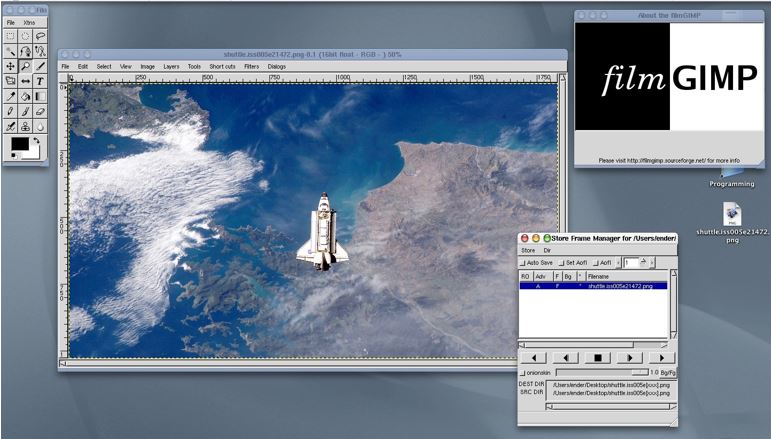

- #Cinepaint mac how to
- #Cinepaint mac mac os x
- #Cinepaint mac portable
- #Cinepaint mac pro
- #Cinepaint mac code
Note that libunistd is deliberately a very thin implementation covering only the most basic POSIX calls that everyone uses.
#Cinepaint mac code
That this file is standard on nix systems but not present on Windows is the trick to making code portable. Including unistd.h on Linux does no harm. Just include unistd.h and it will straighten out the Windows mess. Most of Windows POSIX implementation is in, but you don't need to know that. There are many deliberately empty POSIX headers in libunistd so that Windows won't complain about missing Linux POSIX headers. Many POSIX calls are available in Windows to support its implementation of BSD sockets, but have non-standard header names. If you're running sockets from a Windows command-line app, there's a magic start-up function called StartWinsock() you'll need to call. You'll also need to link to Windows' Winsock library and possibly its Common Controls library.

That has implementations of opendir and gettimeofday. You'll want to statically link to the (tiny) libunistd library. The whole point of libunistd is to eliminate that junk. You should not need any #ifdef WIN32 code in your app. To use libunistd simply #include in your code and set your Windows build path to find it. A Windows pthreads port is available from Red Hat or there's a chopped down lite version I created in CinePaint CVS.
#Cinepaint mac portable
Portable programs can be revised to handle POSIX threads (pthread) instead. It also allows iostream.h and fstream.h to substitute for their non-dot-h counterparts in VC++. Libunistd supports open/read/write/close, dlopen, opendir, gettimeofday, and the typical BSD socket calls accept/bind/connect/listen/select/socket. Using libunistd, many Linux terminal-based apps will build on Windows as-is or with only minor changes. Libunistd is a very thin POSIX wrapper created by Robin Rowe that enables building typical Linux code on Windows with VC++. Post a Comment Tuesday, February 26, 2008 There are other options out there, but I see CinePaint has a bit more activity and community, and I hope it does well! LOVE the LOGO!!! CinePaint seems as though it will fit best into my workflow for a raster image editor replacing the 8-bit per channel editor I've become familiar with. I'm evaluating CinePaint for my Photography purposes, and I hope I like it as much as I have liked the GIMP in the past! Having moved on to higher bit depth scans and RAW shots, I have to pick up a new toolset. configure options for Gentoo Linux on my blog at I would like to thank Aedan Kelly for putting in the work to make CinePaint capable of utilizing the GTK+2 widget set. Hello, and thanks for developing on the CinePaint codebase. Valuable resource of volunteer news summaries: Posted by Robin Rowe 1:13 AM 2 comments 2 Comments:
#Cinepaint mac how to
Are you interested in learning how to build UNIX-based code on Mac OS X? A great project for someone who wants to play with xcode and master the basics of package management on Mac OS X.
#Cinepaint mac pro
Knowledge or desire to master Mac-native GUI API necessary.ĬinePaint is popular advanced image editing software used by pro photographers and studio visual effects artists. A great project for someone who wants to play with xcode and create ports of popular Linux apps on Mac OS X. Our Mac developer resigned to join Apple. It works well enough to support simple apps, but not CinePaint yet.

#Cinepaint mac mac os x
Some knowledge or interest in learning C, Perl, and autotools needed.Īre you interested in having Linux GTK+ GUI code build natively on Mac OS X without X11? CinePaint has a native Mac port of GTK+ that's made a lot of progress. An easy Perl embedding project that doesn't present a high bar. Minor C coding (switch/case) is needed to handle interfacing 16-bit and 32-bit color channels. GIMP plug-ins usually port easily to CinePaint because the API is similar. Although superficially similar, CinePaint has a more powerful graphics engine that enables it to handle high fidelity image files (such as OpenEXR files output from Blender). This project is to port the Perl plug-in from GIMP to CinePaint. CinePaint is popular advanced image editing software used by pro photographers and studio visual effects artists.Īre you interested in learning how to embed Perl in a GUI app? A great project for someone who wants to play with Perl and graphics.


 0 kommentar(er)
0 kommentar(er)
